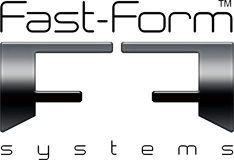Top safety tips when using formwork
28.06.2021
Construction sites can be dangerous places and there are lots of health and safety procedures to consider. Fast-Form formwork was designed with safety in mind as we provide full structural calculations with our products and no part weighs more than 25kg. However, we also have a number of tips that may help when choosing and using formwork.
- Choose the right formwork
You may be surprised to hear how many people don’t consider the type of formwork they need before they get in touch with us. Conditions vary at every job site, so there is no simple formula for choosing the right type of formwork. The best thing to do is get in touch to discuss your requirements, so we can advise on the best formwork for your project.
- Get involved in the project early
Get in touch with your formwork supplier before you start construction on the project. By getting them involved during the design process, it means that they have as much information as possible in order to design the best formwork solution for your project. As formwork suppliers, we always find it easier to advise clients on the sizing of structural concrete if we are working from original drawings. Our internal design team, using the very latest technology, will create a design of the formwork required, as well as accurate costings on Rental or Purchase.
- Decide whether to purchase or hire formwork
Whether you decide to purchase or hire formwork depends on how long the project is going to take to complete, and the overall strategy of the company. If the formwork is going to be in place for longer than eight months, it may be more economical to purchase rather than hire. You do have to factor in extra costs if you go down the purchase route though, such as maintenance and storage of the formwork.
- Ensure proper site access
Access on a jobsite is very important, but even more so when formwork is involved. Construction workers need to be able to access the working area using both horizontal and vertical access routes. Ladder systems are often included within the original formwork designs to enable easy access to every point on the formwork. Fast-Form formwork systems incorporate access handrails and toe boards for additional safety.
- Ensure proper handling of equipment
After you have invested all that time and money into the correct formwork for your construction project, you don’t want things to fall down at the last hurdle. It’s important that contractors closely follow the engineering drawings when it comes to setting up the formwork. These instructions have been created for a reason, and if they are not adhered to, the structure could become unsafe and hazardous.
- Don’t overlook formwork ties
Properly installed ties will hold the formwork in place safely while the concrete is poured. If this is not done correctly, you could have a real problem on your hands. It is also worth keeping the maximum pour pressure in mind – this will be included within the design. Pouring the concrete too fast, for example, could create excess pressure on the forms which they may be unable to withstand.
- Choose the best method of assembly
Formwork can be pre-assembled at the point of manufacture or it can be built on site. This depends on the site conditions, required finish or whether or not you have a crane on site. Fast-Form have a hand-fit system and crane lifted systems so we can design the system to suit your needs. If you’re assembling the formwork yourself, it’s a good idea to make sure your staff are trained on how to properly and safely use the forming equipment.
If you would like any further information about Fast-Form’s formwork hire and sales service, please contact us today.



